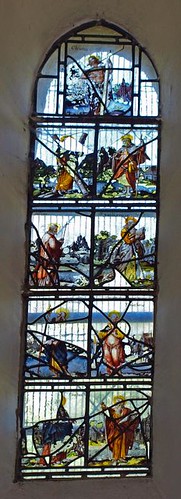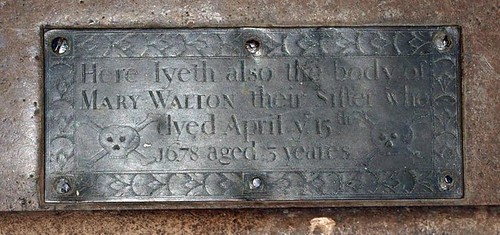I rather liked the straightforward exterior Nave and Chancel with a plain wooden belfry, the simple interior and a, what I took to be, much damaged Flemish window - it's not a top ten but if you like simplicity and a lovely location it's well worth a visit even if it is normally locked; not something I often say.
ST MARY. In a nice position overlooking rolling country. Wooden belfry, C15, resting on six posts with beams on braces, and crowned by a shingled broach spire. Norman nave - see one N window. Also in the N wall of the nave a small C13 lancet. Chancel with early C16 brick windows, three-light with Perp panel tracery at the E end, two-light on the S side. The nave roof is of the C15 and has tie-beams on braces and king-posts. The braces rest on angel corbels. The chancel roof, a little later, has braces connected with the tie-beams by tracery. - PLATE. Cup and Paten of 1629.
LITTLE BURSTEAD. It looks across the flat country stretching to the Thames, and has two Elizabethan houses, Hatches Farm and Stockwell Hall. The hall has a great clock with a face on which the figures are in blackened bones. The tiny church is 700 years old, built on a knoll and seen from afar. The nave is only 12 yards long, its west end filled with grand old beams supporting the medieval turret and its shingled spire. The tower arch is fashioned from the timbers. There is a brass engraved with skulls in memory of Mary Walton of 1678, and under the chancel lies that Sir George Walton who served under Rodney, captured a squadron of Spanish ships at one fell swoop, and in reporting to the Admiralty wrote, “the number as per margin.”
There is a little medieval woodwork preserved from the old screen and worked into the new, a little more in the modern reredos, and the church has treasured a piece of oak with fading colours which formed a background to a little altar before the Reformation. Two windows have delicately coloured glass of the 17th century, one with portraits of Christ and eight Apostles, each in a perfect little landscape. They are gems, probably by an artist from Flanders. One has Philip carrying a rustic-looking cross as he goes out to evangelise the world. The font is 15th century, and so is the roof, and on the doorway are mass dials by which the village told the time in the days before clocks.
Simon K -
A disgracefully neglected little church, as if it has already been abandoned. Very sad. I headed on through reassuringly remote lanes to Heronsgate and then down the Thurrock road to East Horndon.
There is a little medieval woodwork preserved from the old screen and worked into the new, a little more in the modern reredos, and the church has treasured a piece of oak with fading colours which formed a background to a little altar before the Reformation. Two windows have delicately coloured glass of the 17th century, one with portraits of Christ and eight Apostles, each in a perfect little landscape. They are gems, probably by an artist from Flanders. One has Philip carrying a rustic-looking cross as he goes out to evangelise the world. The font is 15th century, and so is the roof, and on the doorway are mass dials by which the village told the time in the days before clocks.
Simon K -
The village sits just to the south of Billericay, the church some way south of it, remote, locked, and not taking part in the Historic Churches Bike Ride. No sign up on the main road to tell you this - thanks guys, I hope you won't mind me putting in an objection if you ever apply for a grant from the Essex Historic Churches Trust.
A typical small Essex church, a quarter of a mile or so from the nearest lane, wooden bell tower. The view below is of the vast Thames Valley industrial complex - you could just make out the Dartford crossing.


No comments:
Post a Comment